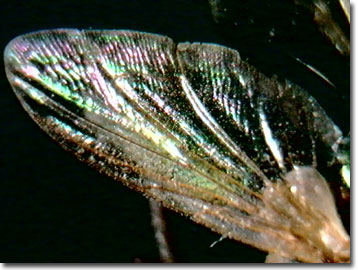Reflected Light Digital Image Gallery
House Fly (Musca domestica) Wing
Usually the cause of disgust because of its distasteful feeding and sanitary habits, and its developmental cycle (producing maggots), the house fly (Musca domestica) has capabilities that rival some of the best defense industry innovations. Its compound eyes, chemosensory organs, wings, and motion detection abilities, coupled with high reproductive rates and advanced external digestion process, combine to make the house fly one of the world's most successful insects.

These dipterans are among the speediest with an average speed of five miles per hour and burst speeds up to 15 miles per hour when threats are detected. Beating about 1,000 times per second, the wings are the source of the buzzing noise that accompanies a close encounter with a house fly. Development of the wings occurs during the pupal stage of the fly life cycle.
M. domestica features veined wings that can carry individuals up to 20 miles, although most stay within one to two miles of their birth place, if sufficient food supplies exist. Insect wings are thought to have evolved from a gill-like thoracic segment present in early insects; and the capability of flight enabled them to increase the area available for finding food, shelter, and for breeding.
The area between veins consists of a cellular membrane with hair-like projections. Functional wing systems occur only in adult insects, so that any house fly observed flying can be considered an adult. Many insects are easily identified by their distinctive wing shapes, colors, and patterns, and house flies are distinguished from similar dipterans by their wing vein pattern.
Recent anatomical research finds that the house fly eye feeds information to vestigial organs referred to as halteres, rather than to the muscles of the single set of wings. The halteres, remnants of a second wing set, act as the gyroscope for this agile flier and relay signals to the wing muscles to alter their stroke or angle of attack. Within 30 milliseconds, a house fly visually detecting a threat can change course while in flight. Aeronautical engineers are far from imitating the aerodynamics and aerobatics exhibited by this nuisance insect, including deft landings and takeoffs, achieved from any surface, whether flat, inclined, or inverted, as from a ceiling. Apparently the Coriolis force is harnessed by this common house pest, utilizing sensory cells (campaniform sensilla) that send signals to the steering nerves of the wing, and alter the reflex beating to stabilize flight or rapidly change direction.
Contributing Authors
Cynthia D. Kelly, Thomas J. Fellers and Michael W. Davidson - National High Magnetic Field Laboratory, 1800 East Paul Dirac Dr., The Florida State University, Tallahassee, Florida, 32310.
BACK TO THE REFLECTED LIGHT IMAGE GALLERY
BACK TO THE DIGITAL IMAGE GALLERIES
Questions or comments? Send us an email.
© 1995-2022 by Michael W. Davidson and The Florida State University. All Rights Reserved. No images, graphics, software, scripts, or applets may be reproduced or used in any manner without permission from the copyright holders. Use of this website means you agree to all of the Legal Terms and Conditions set forth by the owners.
This website is maintained by our
Graphics & Web Programming Team
in collaboration with Optical Microscopy at the
National High Magnetic Field Laboratory.
Last Modification Friday, Nov 13, 2015 at 02:19 PM
Access Count Since September 17, 2002: 15189
Visit the website of our partner in introductory microscopy education:
|
|
